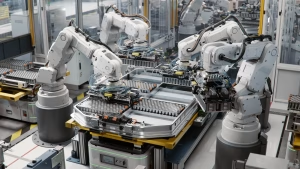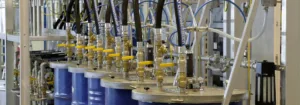Updated: Oct 8, 2025
Understanding the Complexities of Air Motors in Industrial Automation
In the evolving world of industrial automation, air motors—also known as pneumatic motors—are valued for their safety, reliability, and adaptability in demanding environments. They excel where electric drives may not, such as in flammable, wet, or dusty conditions, making them a trusted choice across manufacturing, assembly, and process industries.
However, while air motors offer high starting torque, robust performance, and precise speed control, they also bring a unique set of challenges that engineers must address to achieve optimal automation performance.
Key Challenges in Using Air Motors for Automation
1. Energy Efficiency
Generating compressed air is inherently energy-intensive, and inefficiencies in the system—such as leaks or pressure drops—can significantly increase operational costs.
- Air motors typically convert less energy into usable work compared to electric motors.
- Even small air leaks can lead to major energy losses over time.
Pro Tip: Regularly conduct leak detection audits, and use energy-efficient air compressors to reduce waste and improve overall system efficiency.
2. Speed Regulation and Control
While air motors excel at quick starts and stops, maintaining consistent speed under varying loads can be difficult. Achieving higher speeds often requires greater air consumption, which can affect system balance.
- Air pressure fluctuations can impact motor speed stability.
- High-speed operations may demand advanced control systems to maintain precision.
Solution: Integrate pressure regulators with high flow rates and feedback loops using sensors or proportional valves to enhance speed accuracy.
3. Total Cost of Ownership
At first glance, air motors can seem more affordable than electric motors. However, the ongoing cost of compressed air generation, filtration, and maintenance can outweigh the initial savings.
- Additional components—like regulators, lubricators, and filters—add to overall system expenses.
- Inefficient air networks increase operational costs.
Optimization Tip: Always evaluate total cost of ownership (TCO), including compressor energy use, maintenance, and downtime risk.
4. Noise Levels
Air motors naturally produce higher noise levels during operation due to air exhaust and mechanical vibration. In some environments, this may exceed acceptable occupational noise standards.
- Noise control is critical in indoor or cleanroom environments.
- Prolonged exposure can impact operator safety and comfort.
Solution: Implement noise-dampening enclosures, or use quieter vane-type air motors when possible.
5. Limited Power Output
Compared to electric motors of the same size, air motors typically offer lower continuous power output. This limits their use in applications requiring sustained high torque or high-speed operation.
- Best suited for intermittent-duty tasks or variable load processes.
- Not ideal for high-horsepower automation setups.
Tip: Choose air motors for high-torque, low-speed operations—like clamping, mixing, or driving small conveyors.
6. Air Quality Dependence
Air motors rely on clean, dry, and lubricated compressed air. Moisture, oil, or dust in the air supply can quickly degrade motor components, reducing lifespan and efficiency.
- Contaminated air causes corrosion, sticking vanes, and mechanical wear.
Solution: Install air dryers, filters, and lubricators to maintain consistent air quality and reduce failure risk.
7. System Complexity
A complete air motor system involves compressors, air lines, regulators, and valves, creating more complexity than an electric setup.
- Larger infrastructure footprint required.
- Increased installation and maintenance demands.
Optimization Tip: Simplify system design with modular air motor setups and efficient pipe sizing to minimize pressure drops.
8. Maintenance Requirements
Though air motors are durable and simple in design, they still require regular preventive maintenance for consistent operation.
- Lubrication schedules and filter changes are essential.
- Ignoring small maintenance tasks can lead to costly failures.
Solution: Implement a preventive maintenance plan with scheduled inspections, lubrication intervals, and part replacements.
How to Overcome the Challenges
Despite these hurdles, air motors remain a powerful solution for automation—especially in hazardous, high-torque, and moisture-prone environments. The key lies in proactive system design and optimization.
| Challenge | Solution |
|---|---|
| Energy inefficiency | Regular leak detection, optimized pressure, and efficient compressors |
| Speed control | Use regulators, sensors, and proportional valves |
| High cost | Evaluate total ownership, use energy recovery systems |
| Noise | Apply silencers and enclosures |
| Limited power | Choose suitable torque-speed profiles |
| Air quality | Maintain filtration and drying systems |
| Complexity | Design compact, modular pneumatic systems |
| Maintenance | Apply predictive maintenance and monitoring tools |
By addressing these areas, manufacturers can leverage the strengths of air motors—durability, safety, and control—while minimizing performance drawbacks.
Conclusion
Air motors continue to play a vital role in automated production lines, particularly where explosion-proof operation, variable torque, and mechanical resilience are required.
By understanding their challenges and implementing effective mitigation strategies—such as energy optimization, smart control systems, and proper air quality management—engineers can unlock the full potential of pneumatic motors in automation.
For further guidance and technical specifications, consult the Atlas Copco Pocket Guide to Air Motors or contact our experts for customized support.the strengths of air motors while minimizing their drawbacks, ensuring a successful and efficient automation solution.


